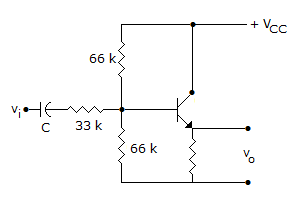Electronics and Communication Engineering - Analog Electronics
Exercise : Analog Electronics - Section 1
- Analog Electronics - Section 11
- Analog Electronics - Section 21
- Analog Electronics - Section 20
- Analog Electronics - Section 19
- Analog Electronics - Section 18
- Analog Electronics - Section 17
- Analog Electronics - Section 16
- Analog Electronics - Section 15
- Analog Electronics - Section 14
- Analog Electronics - Section 13
- Analog Electronics - Section 12
- Analog Electronics - Section 1
- Analog Electronics - Section 10
- Analog Electronics - Section 9
- Analog Electronics - Section 8
- Analog Electronics - Section 7
- Analog Electronics - Section 6
- Analog Electronics - Section 5
- Analog Electronics - Section 4
- Analog Electronics - Section 3
- Analog Electronics - Section 2
21.
In the amplifier circuit of figure hfe = 100 and hie = 1000 Ω. The voltage gain of amplifier is about


Answer: Option
Explanation:
 .
.
22.
The efficiency of a full wave rectifier using centre tapped transformer is twice that in full wave bridge rectifier.
Answer: Option
Explanation:
Efficiency of full wave rectifier with centre tapped transformer is slightly higher than that of bridge rectifier.
23.
Assertion (A): CE amplifier is the most widely used BJT amplifier
Reason (R): CE amplifier has zero phase difference between input and output
Answer: Option
Explanation:
There is 180° phase difference between input and output.
24.
Assertion (A): For large signal variations an amplifier circuit has to be analysed graphically
Reason (R): The output characteristics of a transistor is nonlinear.
Answer: Option
Explanation:
Since the characteristics is non-linear, graphical analysis is needed.
25.
Negative feedback reduces noise originating at the amplifier input.
Answer: Option
Explanation:
It has no effect on noise originating at amplifier input.
Quick links
Quantitative Aptitude
Verbal (English)
Reasoning
Programming
Interview
Placement Papers